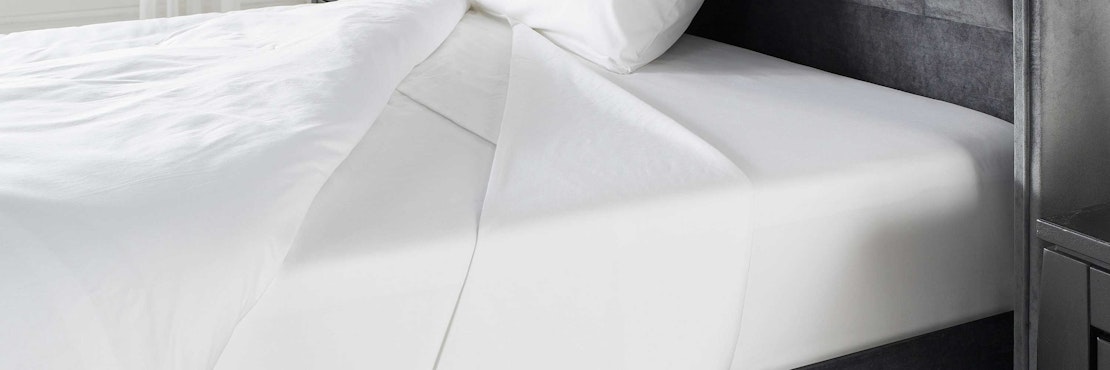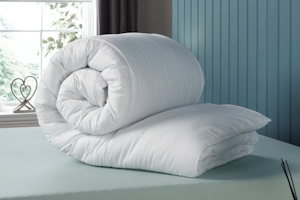20 Mar 2025

How Can I Prevent Bedding From Shrinking?
24 Jul 2023
Bedding is an essential part of our everyday lives, and we want it to be comfortable and long-lasting. However, it can be all too common for our favourite sheets, blankets, and duvet covers to experience changes in texture or size over time. A common issue faced by many is the shrinkage of bedding materials, which can be both inconvenient and frustrating. In this article, we will explore the ways to prevent bedding from shrinking and ensure that you get the most use out of your bedding items.
Understanding why bedding materials shrink is crucial in finding ways to prevent it. One of the primary reasons for shrinkage is the use of heat while washing and drying your bedding. Natural fibres like cotton and linen become stretched and tense during the production process, which is why they're prone to shrink when exposed to heat in the laundry process. By being aware of the types of fabric you're dealing with, you can take appropriate action to avoid unwanted shrinkage.
To prevent your bedding from shrinking, you need to make informed decisions about the material you choose, the washing and drying practices you follow, and the size of the bedding items you purchase. Familiarising yourself with different fabric types, their specific care instructions, and appropriate techniques to manage them can go a long way in preserving the look and feel of your bedding.
Key Takeaways
- Shrinkage occurs primarily due to heat exposure during washing and drying
- Knowing fabric properties and care instructions is crucial for proper maintenance
- Material selection, washing practices, and bedding size matter for preserving quality
Understanding Fabric Shrinking
When it comes to preventing bedding from shrinking, it is essential to first understand the reasons behind fabric shrinkage. Different types of fabrics may shrink differently due to variations in their fibre composition, fabric structure, and the ways they react to heat and moisture.
Cotton and linen are natural fibres that can shrink when exposed to heat and moisture. The shrinking occurs as fibres contract and revert to their original size, compressing the fabric's structure. To prevent cotton and linen bedding from shrinking, you should wash them in cold water and on a delicate cycle. Avoid using hot water or tumble drying, as heat can contribute to further shrinkage.
Wool is another natural fibre that can shrink, but it does so through a different mechanism called felting. This occurs when the scales on the surface of animal fibres begin to interlock and tighten when exposed to heat, moisture, and agitation. To prevent wool bedding from shrinking, handwash or use a gentle machine cycle with cold water and a wool-specific detergent. Ensure that the bedding is dried flat and out of direct sunlight to prevent distortion.
Synthetic fabrics such as polyester and microfiber normally have a lower risk of shrinking due to their synthetic nature. However, they can still shrink if exposed to high heat. To maintain the size of your synthetic bedding, always use a cool or warm wash setting and avoid high heat when tumble drying.
In general, when laundering your bedding, it is best to follow these guidelines:
- Use cold or lukewarm water for washing
- Select a delicate or gentle wash cycle
- Avoid tumble drying on high heat
- Dry the bedding in a properly ventilated area out of direct sunlight
By understanding the reasons behind fabric shrinkage and following these simple guidelines, you can maximise the lifespan of your bedding and keep it in optimal condition.
Pre-Shrinking Techniques
Washing and Drying
To prevent your bedding from shrinking, it's important to implement proper washing and drying techniques. Always follow the care instructions on the bedding's label. Generally, washing your bedding in cold water can help reduce the risk of shrinkage. Be sure to use a gentle cycle, as agitation from vigorous cycles may contribute to shrinking.
When it comes to drying, it's recommended to air-dry your bedding if possible. Alternatively, using a low-heat setting on your tumble dryer can work as well. By doing so, you prevent the fabric from being exposed to high heat, which is known to cause shrinkage. Lastly, avoid over-drying your bedding, as this can lead to wrinkles, wear, and more rapid shrinkage.
Steam Ironing
Another effective pre-shrinking technique is steam ironing your bedding. This method involves using a steam iron to gently press the fabric, producing heat and steam that can help relax and pre-shrink the fabric before use.
To do this, first ensure your iron is filled with water and set to the appropriate heat setting for the fabric type. Lay your bedding on an ironing board, making sure it's spread out evenly without creases. Press the steam button on your iron to release steam while smoothly gliding it over the fabric. Cover all areas of the bedding, ensuring it's evenly treated.
By using steam ironing as a pre-shrinking technique, you can help to minimise the risk of shrinkage when your bedding is later washed and dried. Just bear in mind that steam ironing may not work as effectively on certain fabrics or materials, so always consider your bedding's care instructions before proceeding.
Selecting the Right Bedding Material
When choosing bedding, it's essential to consider the type of material you will be using, as this can affect the likelihood of shrinking. In this section, we will explore two types of fibres: Natural and Synthetic.
Natural Fibres
Natural fibres, such as cotton, linen, and wool, are known for their softness, breathability, and durability. However, they are also prone to shrinkage. To prevent this, make sure to follow these tips:
- Always check the care label on your bedding for specific washing instructions.
- Wash items on a gentle cycle, using cold water.
- Avoid placing natural fibre bedding in the dryer. Instead, lay them flat or hang to dry.
- If you must use a dryer, ensure it is set on a low heat setting.
While natural fibres may require extra care, their comfort and eco-friendliness make them a popular choice for many people.
Synthetic Fibres
Synthetic fibres, such as polyester and microfiber, are less likely to shrink compared to natural fibres. They generally require less maintenance and may be washed at higher temperatures. However, they may not provide the same level of comfort as natural materials. To properly care for synthetic bedding:
- Check the care label for specific washing and drying instructions.
- Machine wash synthetic bedding on a regular cycle, using warm or cold water.
- Tumble dry on a low heat setting, or hang to dry, if preferred.
By paying attention to the type of bedding material you choose and following appropriate washing and drying guidelines, you can significantly reduce the risk of shrinkage and enjoy your bedding for a longer period.
Proper Washing and Drying Practices
Washing Instructions
To prevent your bedding from shrinking, it's essential to follow proper washing instructions. Here are some tips to help you:
- Check the care label: Before washing your bedding, always read the care label for specific instructions regarding temperature settings, detergent types, and any other washing recommendations.
- Use cold water: Washing your bedding in cold water can help prevent shrinkage. Most detergents are made to work efficiently in cold water, so your bedding will still be cleaned effectively.
- Choose a gentle cycle: Select a gentle cycle on your washing machine to minimise agitation, as this can cause fibres to shrink. Avoid using a high spin setting for the same reason.
Drying Procedures
Proper drying techniques are just as important as washing procedures when it comes to preventing shrinkage in your bedding. Keep these steps in mind:
- Avoid high heat: High heat in the dryer is a leading cause of shrinking fabric. Instead, use a low heat setting or a 'delicate' setting if available.
- Air dry when possible: The best way to prevent shrinkage is to air dry your bedding. Spread out the bedding flat on a clean surface, such as your bed, and flip it occasionally to ensure even drying.
- Consider professional cleaning: If you're unsure of the best way to care for your bedding, consider opting for a professional dry cleaning service. They use non-water based chemical solvents during the cleaning process, which can help prevent shrinkage.
By following these washing and drying guidelines, you can maintain the original size and feel of your bedding for longer. Remember, proper care is crucial in preserving the quality and lifespan of your bedding.
Bedding Size Considerations
When you're shopping for bedding, it's essential to consider the size of your sheets and other linens to avoid shrinking issues. In this section, we'll discuss two sub-sections on bedding size considerations: Buying Over-sized Bedding and Using Mattress Pads.
Buying Over-Sized Bedding
One way to prevent shrinking issues with your bedding is by purchasing over-sized sheets and duvet covers. This allows for some shrinkage to occur during washing without affecting the overall fit on your mattress. When selecting over-sized bedding, consider the following tips:
- Look for bedding labelled as 'extra-large' or 'over-sized'.
- Measure your mattress and add a few centimetres to each dimension to compensate for potential shrinkage.
- Choose bedding made from natural materials, like cotton or linen, which are more likely to shrink. Synthetic materials, like polyester, are less prone to shrinkage.
Using Mattress Pads
Another bedding size consideration to prevent shrinking is using mattress pads. A mattress pad can add extra protection to your mattress while also providing additional cushioning for your body. Here are some benefits of using mattress pads in conjunction with your bedding:
- A mattress pad can help maintain the shape of your fitted sheet, reducing the chances of shrinkage.
- Some mattress pads are designed to be slightly larger than the mattress to allow for a better fit after potential sheet shrinkage.
- Mattress pads can provide an additional layer of protection, keeping your mattress clean and prolonging its longevity.
Remember to take these bedding size considerations into account when selecting bed linens to increase the chances of preventing shrinkage and ensuring a perfect fit on your mattress.
Caring for Your Bedding
Regular Cleaning
To prevent your bedding from shrinking, it is essential to clean it correctly. Always follow the care instructions on the label. Use cold or lukewarm water for washing your bedding, as higher temperatures can cause shrinkage. When washing cotton bedding, avoid using heat as much as possible. For linen bedding, opt for high-quality products that have been pre-washed to minimise shrinkage.
Use a gentle detergent and avoid using bleach or fabric softeners, which can damage the fabric and increase shrinkage risk. When it comes to drying, air-drying is the best method for preventing shrinkage. Laying your bedding flat or hanging it on a line to dry will ensure that it maintains its shape. If you must use a tumble dryer, always choose the lowest heat setting and remove your bedding before it is fully dry, allowing it to finish air-drying.
Storing Bedding Properly
Proper storage of your bedding is another crucial aspect of preventing shrinkage. Make sure your bedding is completely dry before storing it away to avoid mould and mildew growth. Keep your bedding in a cool, dry, and well-ventilated area. It is best to store your bedding in breathable storage containers or bags, such as those made from cotton or a fabric with a loose weave.
Fold your sheets and duvet covers neatly before storing them to help them retain their shape and prevent excess wrinkling or creasing. Stack similar items together and avoid overstuffing your storage space, as excessive compression can damage the fabric and contribute to shrinkage.
By following these guidelines for regular cleaning and proper storage, you can effectively prevent your bedding from shrinking and maintain its quality and comfort for years to come.


